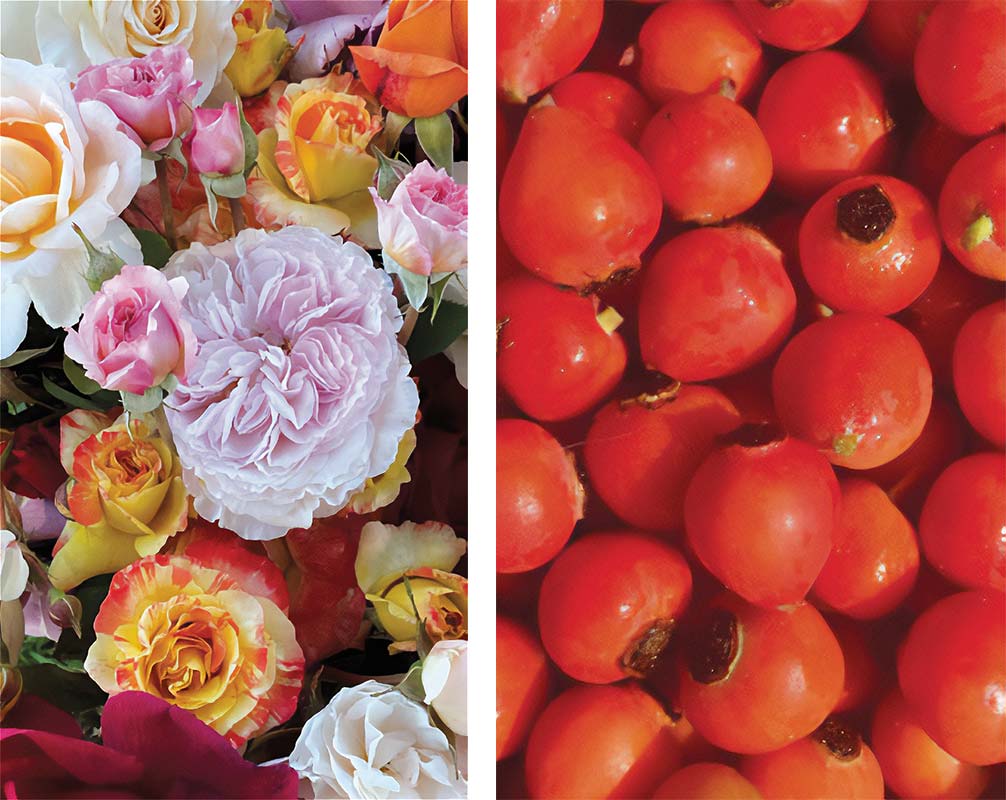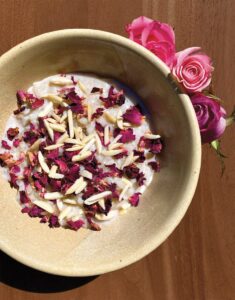
Roses are beloved for their flowering charm in the garden. They speak of romance and beauty, luxury and aristocracy. They offer up the allure of the most perfect complex fragrances. So it may come as a slight surprise to learn that roses also have a rich and deep history of use in the kitchen as well. Wild roses grow naturally and prolifically on three continents—Europe, Asia and North America. Here in the Monterey Bay area, we have the delightful California wild rose, Rosa californica, called mamawkwa in the Mutsun language, which was used by Indigenous people for both a food and a beverage of soaked blossoms.
With such natural abundance, it’s no wonder roses were a prized ingredient on the tables of royalty and commoner alike throughout the centuries. Sweet and savory, meat and vegan dishes, appetizer, main dish and dessert, perfume and drink. Roses can do it all.
Roses are in the same plant family as apples, Rosaceae, so of course they are delicious.

FLOWER EATERS
Roses are in the same plant family as apples, Rosaceae, so of course they are delicious. The petals call out to be tasted, in all their shades of pink, red, coral, crimson, gold, yellow, cream, white and lavender. Don’t be shy. Take a fresh petal and taste it on your tongue. The white inner edge can be a bit bitter, so just tear it off and enjoy the rest. Roses come in thousands of different varieties and each one can offer a slightly different scent and taste. Follow your nose. A deep fragrance is a good indicator of a tasty rose, and the flavors will vary with notes of fruits like green apple or strawberry, pine, jasmine tea, honey, myrrh and musk, changing with the time of day and location as well as variety.
Rose petals can be used in salads, to top a soup, as a garnish on any plate and as a beautiful decorative element for cakes and pastries. Small rose buds can also be incorporated into quick stir-fry dishes and soups. Buds can also be roasted along with vegetables for a particularly fragrant accent. To create a complex flavor combination, add rose petals to a standard pesto recipe with pine nuts, olive oil, basil and Parmesan for a more floral variation of the classic preparation.
Certain flavors have been paired with roses traditionally. Cardamom and pistachios in Persian foods are a common combo, lavender for the French and violets for the British. Almonds, lemons and jasmine are other delectable foils for the flowers.
Drying rose petals and buds extends their tragically short usage window. Fresh petals and buds will last only a day at room temperature, and maybe two to three days if stored in the refrigerator. Carefully dried petals and buds, however, can be stored and used for up to a year while retaining color, scent and flavor. To dry them, put them in a dehydrator at 95° F for 12 hours, or until completely dry to the touch. Leaving them in a warm and dry location to air dry works as well. Then store the dried petals in dark glass containers out of the sun and heat, sprinkle for a bit of sparkle on any sort of special occasion.

ROSE HIPS
Not only are rose flowers themselves edible, but the seeded “fruits” that form after the flower fades, known as rose hips or rose haws, are also comestible. The word hips has been used to refer to the fruit of the rose plant since at least the 14th century in Old English. The rounded form of the human shape is reflected in the plump berries that linger on the rose bush long after the flowers have fallen to the winter chill.
Rose hips are most delicious if left on the rose bush until after the first hard freeze. December to January is when I collect them here, making sure not to deadhead the flowers of my favorite rose hip varieties in the fall months. Collect them when they are bright red, before they begin to shrivel and turn brown. Not all rose varieties will make great hips. Rugosa roses, the species found wild and those hybridized from these wild forebears, tend to have the largest, reddest, tastiest hips.
They can be used in everything from bread to pie, and tea to wine, but most commonly in the West they are made into rose hip jam. The Swedish are said to make a soup out of rose hips, called nyponsoppa, which I would like to try someday, and I have read a tasty mead can be made of them as well. Whether eaten raw, cooked or otherwise processed, the tiny hairs inside rose hips must be removed. They are quite literally an itching powder ingredient. To remove these hairs, slice the rose hips in half and scoop out the hairs with a small spoon.
Rose hips are extremely high in vitamin C, which explains some of their popularity in the dark cold wintertime when little else in the way of fruit was historically available. They also contain the antioxidant carotenoids beta-carotene, lutein, zeaxanthin and lycopene. They have not been named a superfood yet, but I see it coming.
THE LIQUID ROSE
Mixologists and tea lovers alike can use rose petals in their creative concoctions. Rose and Meyer lemon lemonade is a perfect spring beverage—just muddle 1 cup of rose petals into the classic lemon juice, honey and sugar mixture, strain them out and serve fresh. Fresh rose petals also make a beautiful topper to more boozy beverages.
Rose syrup can take a craft cocktail to the next level. Rose petal tea has a long and venerated history, enjoyed from Japan to Persia long before this floral tisane made it to these western shores and lands.
Our ancestors figured out many methods to preserve the delicate precious essence of rose in a variety of different fluid forms. The simplest is rose water, which contains only two ingredients, rose petals and water. To make a beautifully colored rose water, use deep red, crimson and fuchsia pink petals. Gather 2 cups of petals, rinse them free of any dirt and then place them in a small pot. Cover the petals with water, and gently heat the water to 200° F, just under a boil, until most of the color from the petals has moved into the water, which should take 10−15 minutes. Strain out the petals and refrigerate the infused water until use. A portion of the rose petals can also be crushed in a mortar and pestle to make a more potent extraction.
Rose water itself can be added to any drink, smoothie, yogurt and many desserts. It can be used as the base for a cold fruit soup or for my personal favorite, rose rice pudding, see below.
Distilling rose water is the next step up, using ice and heat to create a more concentrated rose water. The internet is full of instructions on how to do this, and with such simple ingredients, it’s fun to experiment. Rose water becomes rose syrup by adding an equal amount of granulated white sugar or honey to rose water, and following the same basic process. Rose water and rose syrup are also made commercially and can be bought in higher end stores as well as online.
GROWING CULINARY ROSES
To use roses as food, it is critical to source flowers or rose hips grown purely and naturally without sprays. Most commercial rose growers use pesticides and insecticides liberally, so eating a grocery store or florist bouquet is not recommended. Instead, grow your own or find a kind friend with untreated roses in their garden. Gather your petals, buds and/or hips, and give them a quick rinse to remove any dust or tiny insects.
Then lay them flat in a single layer to dry. The Monterey Bay area climate is perfect for roses. As long as you have a sunny spot in your garden, balcony or porch, you too can grow roses and ensure a delicious floral accent for all of your feasts. I grow thousands of roses on our farm in the Pajaro Valley, and some of my favorite disease resistant varieties for fragrance, bold colors, bouquets and most importantly, culinary uses include: Peter Mayle, sweet mademoiselle, Olympiad, stiletto, Dee- Lish, summer romance and parfuma.
There are more than 5,000 named rose varieties, so feel free to experiment with whatever varieties you may have at hand. Remember, roses are a symbol of love because they are hungry, they are thirsty, and they will cut you. Water them deeply, once or twice a week depending on the weather. Feed them frequently as well, around once a month in the spring and summer, with a balanced organic fertilizer. Wear gloves or specialty rose “gauntlets” available online when you are tending to your plants to avoid the thorns.

About the author
Nadine Schaeffer is a farmer, artist, grower of odd fruits, lover of all roses, lapsed linguist, embarrassed epicurean and inadvertent menagerie keeper living on California’s Central Coast. Birdsong Orchards is her farm in the Pajaro Valley, where she grows over 200 varieties of fruit trees and 1,000-plus roses.
- Nadine Schaefferhttps://www.ediblemontereybay.com/author/nadineschaeffer/
- Nadine Schaefferhttps://www.ediblemontereybay.com/author/nadineschaeffer/
- Nadine Schaefferhttps://www.ediblemontereybay.com/author/nadineschaeffer/
- Nadine Schaefferhttps://www.ediblemontereybay.com/author/nadineschaeffer/


